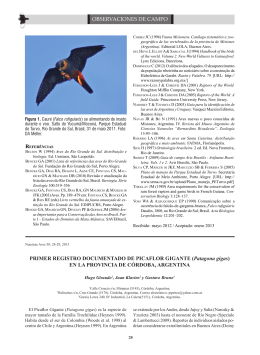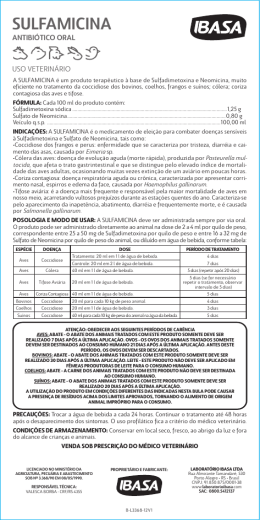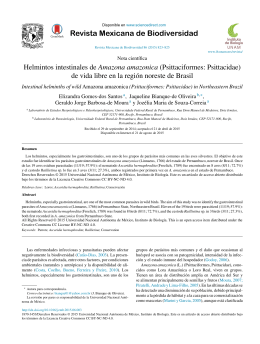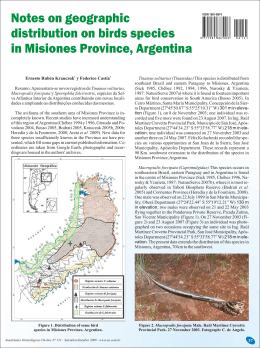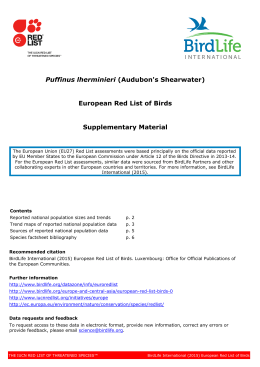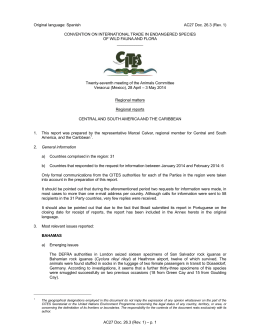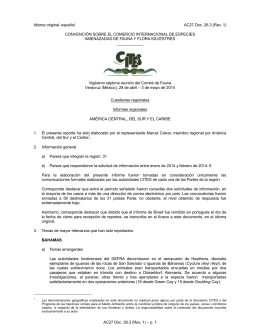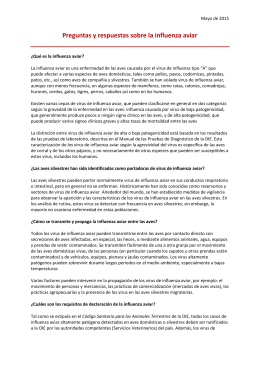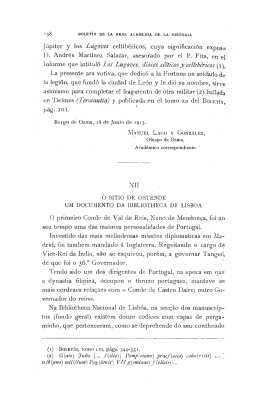Concentrations of Manx Shearwater off San Antonio Oeste, Río Negro, Argentina Bergkamp, P. Y. 1995 Cita: Bergkamp, P. Y. (1995) Concentrations of Manx Shearwater off San Antonio Oeste, Río Negro, Argentina. Hornero 014 (01y02) : 073-074 www.digital.bl.fcen.uba.ar Puesto en linea por la Biblioteca Digital de la Facultad de Ciencias Exactas y Naturales Universidad de Buenos Aires Julio 1995 Nuevas localidades para aves argentinas era conocida de Salta, Jujuy y Tucumán (Olrog 1979), Córdoba (Nores e Yzurieta 1981) y Entre Ríos (Parera 1990). Emberizoides ypiranganus Unos 5 ejs. fueron observados en Colonia Vélaz, depto. Bermejo, Chaco el 9 jun 1989. La especie era conocida de Misiones, Corrientes y Santa Fe (Olrog 1979). Icterus icterus Un ej. fue observado a 6 km al E de Los Blancos, depto. Rivadavia, Salta, el 27 set 1987. Con este hallazgo se confirma su presencia en esta provincia sugerida por Carman (1971) en base a datos de terceros. La especie era conocida además de Formosa (Hoy 1968, Nores e Yzurieta 1986) y del Chaco (Bertonatti y Heinonen Fortabat 1988). AGRADECIMIENTOS El trabajo de campo fue realizado con fondos provenientes de National Geographic Society (Grant No. 3253), de Humedales para las Américas y de CONICOR. BIBLIOGRAFIA CITADA Bertonatti, C. C. & S. Heinonen-Fortabat. 1988. Dos especies nuevas para la Provincia del Chaco. Nótulas Faunísticas 14: 1-3. Carman, R.L. 1971. Información sobre el matico (lcterus croconotus). Hornero 11:127. Contreras, 1. R . 1979. Lista preliminar de los vertebrados de la Reserva Ecológica de Nacuñán. Cuad. Técn. Iadiza 1:39-47. 73 Chebez, J.C. 1980. Sobre la distribución geográfica de tres aves argentinas. Iguazú l:l 0-11. Darrieu, C.A. 1986. Estudios sobre la avifauna de Corrientes. III. Nuevos registros de aves Passeriformes (Dendrocolaptidae, Furnariidae, Cotingidae y Pipridae) y consideraciones sobre su distribución geográfica. Hist. Nat. 6:93-99. Doke, J.D. 1985. El ave fragata en Necochea. Nuestras Aves 6:8. Giai, A.G. 1950. Notas de viaje. Hornero 9:121-164. Hoy, G. 1968. Icterus jamacaii paraguayae (Brodkorb). Un ictérido (Aves) nuevo para la fauna argentina. Neotrópica 14:118. Hoy, G. 1969. Addendas a la avifauna salteña. Hornero 11:53-56. Meyer de Schauensee, R. 1966. The species of birds of South Arrerica and their distribution. Acad. Nat. Scienc. Phila Livingston, Wmnewood. Narosky, S. 1983. Registros nuevos o infrecuentes de aves argentinas. Hornero 12:122-126. Nores, M. & D. Yzurieta. 1981. Nueva~ localidades para aves argentinas. Hist Nat. 2:33-42. Nores, M. & D. Yzurieta ..1983. Nuevas localidades para aves argentinas. Parte V. Hist. Nat. 3:159-160. Nores, M. & D. Yzurieta .. 1986. Nuevas localidades para aves argentinas. Parte VII. Hist. Nat. 6:49-52. Nores, M., Yzurieta D. & S. A. Salvador. 1991. Lista y distribución de las aves de Santiago del Estero, Argentina. Bol. Acad. Nac. Cienc. Cba. 59:157-196. Olrog, C. C. 1979. Nueva lista de la avifauna argentina. Op. LiIloa- na27. Parera, A.F. 1990. Zorzalito migrador (Catharus ustulatus) en Entre Ríos. Nuestras Aves 22:31. Vaurie, C. 1980. Taxonomy and geographical distribution of the Furnariidae (Aves, Passeriformes). Bul!. Am. Mus. Nat. Hist. 166. Hornero 14: 73-74 CONCENTRATIONS OF MANX SHEARWATER OFF SAN ANTONIO OESTE, RIO NEGRO, ARGENTINA PATRICK Y. BERGKAMpl ABSTRACT: Concentrations of Manx Shearwater off San Antonio, Oeste Rio Negro, Argentina, and an apparently undescribed behaviour of the species is reported. From Sep 1992 to May 1993 1 studied Nearctic waders along the coast of San Antonio Oeste, Río Negro, and also collected data on seabirds and waterfowl. From the second week of Oct until the first week of Dec, Manx Shearwater Puffinus puffinus was regularly seen far off at sea (usually at more than 300 m offshore). Total numbers did not exceed c. 500 birds. On 1 Nov, however, a group of c. 650 birds was present at 100m off the coast, near the entrance of Bahia San Antonio 40° 48' S, 64° 55' W, between two sandflats, Banco Reparo in the West and Banco Lobos in the East. The following day the number of birds had increased and 1 estimated the group size at c. 1,400. The flock was slowly moving towards Banco Lobos (where 1 was observing at that time) and more shearwaters, arriving from the East were joining this group. After one hour 1 estimated that 13-15,000 birds were presento While the birds were gathering, the main Ree: jul 1994: aeep: die 1994 1 Inslitute of Systematies and Population Biology, University of Amsterdam, P.O.Box 94766, 1090 GT Amsterdam, The Netherlands group was flying in circles counter clock-wise (diameter 1.5 km) at less than 10m above the sea. Only occasionally did birds sit down on the water to resto When the group reached its peaknumber more birds sat down for a while, apparently to rest or to search for food, as close as 50 m off Banco Lobos. The majority, however, continued to fly in circles. After c. 15 minutes the group started to move in a SE direction towards the open sea, meanwhile continuing the circling movement. Even then birds were arriving from the East, but in smaller numbers, and this went on untilat least 2 hours after the highest estimate, when 1 left the area. Therefore, in total, there must have been more than 15,000 Manx Shearwaters in the Golfo de San Matias at that time. The population size of the Manx Shearwater, which breeds in the NE Atlantic, is 250,000-300,000 pairs (del Hoyo el al. 1993), of which the majority winters off E South America from 10° 10' to 50 (Harrison 1983). In the literature, flocks of this size have not been reported close to South American shores. Moreover, the observed behaviour has apparently not been described. It is tempting to as sume that the presence of large quantities of food caused to congregate in such a large flock and 74 Hornero Vo!. 14 Patrick Y. Bergkamp to perform the peculiar circling behaviour. However, because the majority of the shearwaters did not make any attempt at foraging, this explanation seems doubtful, also because none of the 2,100 Kelp Gulls Larus dominicanus and more than 300 tems Sterna spp (mostly South American Tern S. hirundinacea) left their roosts in the vicinity of the area to join the shearwaters. Another possibility could have been that strong eastern winds blew the shearwaters towards the coast, although the wind this date carne from the SW with force 4-6 Beaufort. Furthermore, in the week prior to this date there were SSW wind, force 6-8 Beaufort. Possibly this longdistance mi- grant gathers in certain areas off eastern South America after its southward migration. Shearwaters are not known to migrate in flocks of more than a few hundred birds. From current knowledge there does not seem to exist a satisfactory explanation for the observed circling movement. 1 wish to thank CJ. Hazevoet and Dr J. Wattel for cornmenting on a draft of this note. LITERATURE CITED del Hoyo J, Elliott A and Sarqatal J. (Eds.) 1992. Handbook of the Birds of the World. Vol l. Lynx Edicions, Barcelona. Harrison P. 1983. Seabirds: an identification guide. Croom Helm, Beckenham Hornero 14: 74-75 OCORRENCIA DA MARRECA CABOCLA Dendrocygna autumnalis NO NOROESTE DO RIO GRANDE DO SUL, BRASIL. DEMÉTRIO L. GUADAGNIN1, JoAo C. DOTTOI y MARIA 1. BURGER1 ABSTRACT. Occurrence of Dendrocygna autumnalis in Northwest Rio Grande do Sul, Brazil. The first undoubted record of the species in the State, at 56° 08' W e 28° 46' S, is given, based on visual observation with slide documentation of two flocks, totalling 236 birds, in may 1991. A marreca cabocla (Dendrocygna autumnalis) distribuise desde o SW dos Estados Unidos até o N da Argentina, exceto Chile (Peters 1979). Sua ocorrencia no Estado do Rio Grande do Sul, Brasil, tem sido um ponto de desacordo (Belton 1984). Pinto (1976) afirma que a marreca cabocla é encontrada "virtualmente em todos os estados do Brasil" e Meyer de Schauensee (1982) cita esta espécie para o Rio Grande do Su!' Entretanto, Olrog (1968) e Madge e Burn (1988) nao incluem este Estado na distribui~ao da espécie. Belton (1984) desenvolveu o estudo mais detalhado de distribui~ao de aves no Rio Grande do Su!' Em seu trabalho cita que Pinto registrou a marreca cabocla para Porto Alegre, mas nao se referiu a nenhum espécimem em particular. Nao existindo nenhum registro seguro, Belton optou por nao incluir a espécie na sua lista. Recentemente, Silva e Caye (1992) publicaram urna lista atualizada das aves do Rio Grande do Sul, nao incluindo a marreca cabocla. Esta espécie também nao está citada para os outros estados da regiao sul do Brasil: Paraná (Scherer Neto 1980) e Santa Catarina (Sick et al. 1981). Em urna expedi~ao realizada em maio de 1991 ao oeste do Estado registramos, no dia 20, um total de 236 marrecas cabocla na Granja Santa Maria, localidade de Rincao de Santa Luzia (560 08' W e 280 46' S), a cerca de tres quilometros do rio Uruguai, no município de Sao Borja. As observa~oes foram feitas com binóculos 10 40 mm. e lunetas 15-6060 mm. e foram documentadas em diapositivos. As aves estavam agrupadas em dois bandos. O primeiro, com 220 exemplares, estava nas margens de um a~ude para irriga~ao de arroz com 220 ha de superfície. Este estava totalmente circundado por lavouras e apresentava algumas manchas de vegeta~ao litoral dominadas por Eichornia Ree oet 1993; aeep die 1994 1 Fundayao ZoobotfuJiea RS, Setor de Manejo de Fauna. CP 1188, 90690000 Porto Alegre, RS Brasil. sp., ciperáceas e gramíneas. As 18 aves restantes foram vistas num pequeno a~ude (1,5 ha) também circundado por arrozais a aprox. 500 m. das primeiras. Em 26 jul 1991,20 marrecas cabocla foram novamente observadas no primeiro ambiente. A espécie nao foi registrada em outras expedi~oes ao NW do Rio Grande do Sul, realizadas emjaneiro e agosto de 1990 e janeiro e novembro de 1991. Estes registros confirmam a presen~a da marreca cabocla no Rio Grande do Su!' Entretanto, o local onde foram avistadas e a inexistencia de registros concretos em outras regioes, sugerem que sua distribui~ao é marginal ou ocasional no Estado. Alternativamente, estes registros poderiam representar urna expansao da distribui¡;ao da espécie. Kramer e Euliss (1986) sugeriram que a espécie está adaptada a expansao agrícola no México ao evidenciarem que a dieta de inverno era constituida predominantemente por arroz e milho. A associa¡;ao com a rizicultura também foi sugerida, entre outros, por Bourne e Osborne (1978) nas Guianas, onde a marreca cabocla também utiliza as restevas de arroz e as margens dos a¡;udes e diques para descanso, e por G6mez-Dallmeier e Cringan (1989) na Venezuela, onde a espécie é considerada urna praga da agricultura. Owre (1973) relata que a espécie colonizou com exito a FI6rida a partir de urna introdu~ao acidenta!. AGRADECIMENTOS Agradecemos BIBLIOGRAFIA a S. Zalba e M. Nores pelas revis6es e opini6es. CITADA Belton, W. 1984. Birds of Rio Grande do Su!' Part 1. Rheidae through Furnaridae. Bul!. Am. Nat. Hist., 178:369-636. Bourne, G. R. e D. R. Osborne. 1978. Black-bellied whistling-duck utilization of a rice culture habitat. Interciencia, 3:152-159. Gómez-Dallmeier, F. eA. T. Cringan. 1989. Biology, conservation and management of waterfowl in Venezuela. Ex Libris, Caracas. Kra.trer, G. W. e N. H. Euliss Jr. 1986. Winter foods ofblack-bellied whistling-ducks in northwestem Mexico. 1.Wlldl. Manage., 50:413-416.
Download
